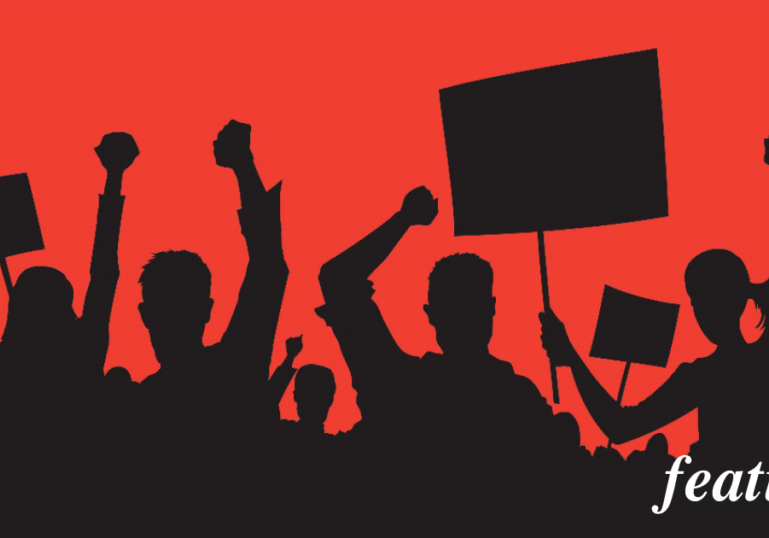Are you an HR professional who finds themselves under pressure to attract and retain top talent amid ongoing labor shortages? If so, you are not alone.
Even as the job markets are cooling off somewhat,[1] many businesses urgently need to continuously acquire and retain the right people to help the organization facilitate its post-pandemic growth efforts. While talent retention is as much a science as an art, HR and business leaders must delve deeply into the intricate dynamics of employee turnover. Why do people choose to leave? Answering this question entails understanding the psychological factors that influence individuals’ decisions to either stay or go, coupled with the daily adoption of data-informed decision-making practices. Insights derived from people analytics are invaluable and equip them with the tools to make educated interpretations and take effective action, empowering them to excel in their roles.
In this article, we aim to share research and science-based facts behind the phenomenon of why some employees leave organizations voluntarily, why turnover can be contagious for others on the team, and how HR professionals can utilize both active and passive listening tools to enhance their ability to create practical and data-based strategies for talent retention.
Behind the Curtains: Voluntary Employee Turnover
Even one of the most fundamental metrics provided by people analytics, the resignation rate of an organization, can be a valuable starting point for the exploration of if an organization may experience an undesirable talent drain. Tracked over time and monitored regularly, a company’s resignation rate provides a sense of if employees decide to call it quits. Suppose this number is above the expected natural turnover rate standard for doing business. In that case, HR professionals can double-click further into the Who and Where the talent drain occurs. They can further compare their organization’s rate to external benchmarks of organizations in similar industries or organizational sizes and put their rate into context.
Double-clicking down on the demographic and business-related information of employees who left the organization can then be supplemented with trends about the resignation rate before homing in further on data gathered from active and passive listening methods that can be employed. While ‘active listening’ refers to ways in which employees are asked directly about their experience at the organization, for example, through engagement and pulse surveys or exit surveys and interviews, ‘passive listening’ methods gather information about employee’s everyday work experience by just observing their collaboration patterns, or well-being indicators for example. Over time, a fuller picture may emerge about whether, where, and why employee turnover may be or become an issue for the organization.
Turnover can be Contagious.
Another related, underestimated factor in understanding voluntary employee turnover is how social relationships between employees influence their propensity to stay or leave the organization. An experimental study using the Visier Community Data of more than 17 million employee records revealed a phenomenon: Sometimes, people leave because others on their team have left the organization.[2]
This effect which is termed “turnover contagion,” was observed both in the case of employee resignations, as well as terminations: most team members quit at higher rates in the following 45-70 days after the first person left, but the risk persists for 135 days (see chart).
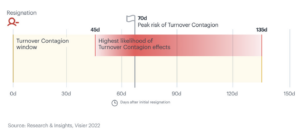
People working together in smaller teams were more prone to follow their peers out the door than those in larger teams: the risk for turnover contagion for employees working in teams sized between two to ten members lies between 12%-25%, compared to larger teams where there is an increased risk of further resignations of between 7%-8%. And this makes sense: smaller teams typically facilitate closer working relationships between employees than larger teams. The remaining peers may have to pick up more work until a replacement is found, as work processes in smaller teams may be more intertwined.
The psychology behind turnover contagion
Turnover contagion reveals a deeply psychological phenomenon that points to the human social connection between employees but also what happens to peers when one of their colleagues leaves. A glance at psychology tells us some of the reasons why people leave and why this effect is more substantial when a teammate quits their job:
People copy each other’s behavior. Social Learning Theory[3] shows us how humans mimic others’ behavior, especially when they can see that their peers got some form of reward for their actions. If a peer moves jobs, gets paid more, receives more development, and is happier, they look to do the same.
People struggle with change. Neuropsychological research tells us that part of our brain, the amygdala, interprets change as a threat and releases the hormones for fear, fight, or flight. Sometimes, people leave because the new situation caused by their peer’s resignation creates a heightened sense of uncertainty that feels uncomfortable and frustrating. Group Think can also come into play when an individual starts questioning their own assessment of job security risk due to someone else deciding to leave before they must.
People feel betrayed. Psychological contract theory tells us that if employees feel the collegial sense of “we are in this together” has been shattered by their peer’s departure, they can question whether they should stay on the job. A violation (or breach) of the psychological contract by the employer – caused by terminations, or layoffs, for example – can have sudden and powerful consequences for the remaining employees, negatively affect job satisfaction, commitment, and performance, and increase turnover intentions.
People develop a fear of missing out. Social comparison theory explains how people process information about how others behave or communicate and what it means for them. “Fear Of Missing Out,” commonly referred to as FOMO, can be triggered by a peer resignation and make employees question their place in the organization. By comparing their peer’s next new job opportunity, which they resign for, to their own, they wonder if they too could benefit from another company’s advancement opportunities or the prospect of a higher salary.
Active and Passive Listening to Tackle Voluntary Turnover
At first sight, voluntary turnover can seem like an unsurmountable obstacle: Employees seem to resign for a whole host of reasons, many seemingly random and deeply personal, while others may be clearly understood but hard to change. And while the turnover contagion effect seems to complicate things further, it teaches us a valuable lesson: every resignation event should trigger a series of immediate actions that could help HR and business leaders mitigate the risk of further resignations on the team.
But with the help of a growing body of research and technological advancement, HR leaders can actively produce information about the remaining team members and learn how likely it is for others to leave with the help of so-called “risk of exit profiles” learn how likely it is for others to leave. By learning about some of the most common reasons or commonalities of people who resigned from their jobs at the organization in the past, they can create strategies for soft-touch approaches to keep peers left behind from also leaving after a colleague’s resignation.
For example, people analytics and HR leaders at Pitney Bowes dug into the turnover issue. They found that amid a national truck driver shortage, this population was at the highest risk of leaving. By utilizing the insights gathered from people analytics, the company could reduce turnover among truck drivers by a few percentage points and achieve higher retention while saving millions of dollars!
To do that, HR teams need reliable data. The good news is that there are various known strategies using an organization’s people analytics capabilities to begin understanding typical reasons for turnover (this is not an exhaustive list).
- Look at Your People Data.
Based on historical data about similarities between employee populations who left, the driving forces behind resignation rates can provide a granular understanding of reasons for quitting. The so-called “Drivers Chart” (screenshot) presents past employee resignations’ most important contributing factors.
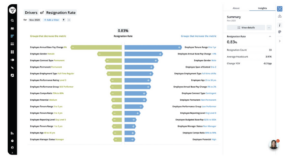
Negatively correlated factors (left in green) and positively correlated factors (right in blue) show which groups or employee attributes are responsible for the resignation rate in an organization. The example shown in the drivers’ charts indicates that resignation rates are driven by low tenure, a lack of pay change, and males working as contractors. Such information zooms in on specific organizational populations and helps HR and business leaders define a more targeted retention strategy around this employee population if desired.
- Actively listen to employees.
Employee surveys can help gauge employee sentiment and engagement and get a continuous sense of people’s satisfaction with the company, its culture, or its role. Lower engagement scores, and changing patterns in these scores, especially if they vary from one business unit to the next, can indicate resignation risks or perhaps even help identify “quiet quitters”- employees who are considered unmotivated workers who are disengaged and only work the bare minimum.[4]
Organizations have been asking employees what they think and feel for decades, and there is value in asking openly for people’s opinions. However, survey results should always supplement, not replace, fact-based data based on historical data or risk of exit models. Since surveys are conducted comparatively infrequently, they present a lagging indicator that could be less valuable.
- Utilize passive listening tools.
In addition to active listening methods, new technologies offer a less biased and time-intensive way for companies to stay abreast of the day-to-day experience of their workers. Passive listening, or gathering passive feedback, involves measuring work patterns within data collected through digital collaboration and communication tools.
For example, with passive listening tools, workers can monitor their collaboration patterns, including peer feedback gathered from micro-surveys with their closest collaborators, and assess their own well-being and burnout risks based on digital day length (when does the employee perform their first and last outgoing digital activity each day) communication quality with others and their everyday workday routine.
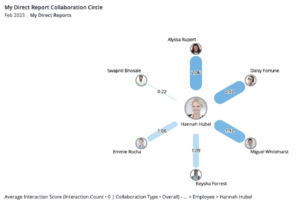
Employees can also assess their well-being and burnout risks based on digital day length, communication quality with others, and their everyday workday routine (see screenshot).
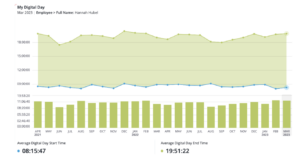
Through passive listening, HR leaders clearly understand how work is performed in real-time and how collaboration is happening across the organization. Employees can access rich and personalized insights to help them maximize their contributions, improve collaboration, and assess their well-being and burnout risks. By analyzing computer usage, communication quality with others, and everyday work routines, employees can better understand their strengths and weaknesses, improving job satisfaction, higher-performing teams, and enhanced productivity. Overall, passive listening is an effective and efficient way for organizations to gain valuable insights into their workforce while minimizing bias and disruption to employees’ day-to-day work.
Analyzed in combination with people data as described above, passive feedback collected during everyday work activities can provide continuous insights for everyone and help detect patterns in employee behavior related to resignation rates. As with any data point about a person, organizations need to implement passive listening tools with the utmost respect toward their employees’ rights for privacy and establish clear rules around the Why of using passive listening tools. The purpose of gathering data and insights about workers’ experience should be to improve workflows, well-being scores, collaboration efforts, or exit risk mitigation strategies, thereby strengthening, not weakening, trust in the company’s talent strategy. Technology is just a tool to provide valuable insights. Still, it is up to the leaders in organizations to decide how the insights gathered can be helpful to the workforce and the business.
HR can proactively use data for employee retention.
The insights gathered from Visier’s research into the phenomenon of turnover contagion further highlight the importance of active and passive listening to always have an eye on the pulse of the employee experience. Employees who quit their jobs almost always leave behind a vacuum that their peers could be quick to fill with their own resignation intentions.
On the bright side, people analytics technologies have come a long way to help address this issue and enable HR and business leaders to gather a comprehensive array of data points that can tell a meaningful and helpful story about why people leave the company or return.[5]
Using such technologies gives HR leaders an excellent opportunity to act, not just react. As the discipline of people analytics becomes the engine behind successful HR practices and programs, HR can own talent retention strategies based on data and facts. A few recommendations for HR leaders to do so are:
- Consider data your guide, not the holy grail. Every data point requires more information.
- Time is your friend. You will learn to understand turnover prediction accuracy by continuously looking forwards and back.
- Be proactive. Use resignations as triggers to respond with a “soft touch” approach, such as career progression initiatives.
- Own the process. Ask your people analytics team for regular risk of exit analyses. Consider implementing differentiated contact and retention strategies for key employees with high resignation risk.
Note from the authors: Many thanks to Morgan Turnipseed for his invaluable contributions to the practitioner recommendations in this article.
Reference
Pitney Bowes, https://bit.ly/3P9KzWo
Endnotes
2 Turnover Contagion is Real. Visier Research & Insights, 2022, https://bit.ly/460JHJm
3 Bandura, A. (1977). Social learning theory. Englewood Cliffs, NJ: Prentice Hall.
5 Boomerang Employees Make a Comeback. Visier Research & Insights, 2022, https://bit.ly/43Un2wI



